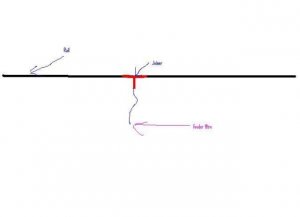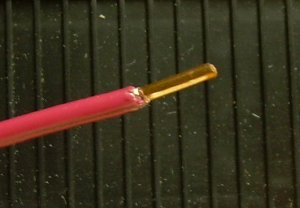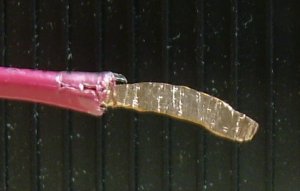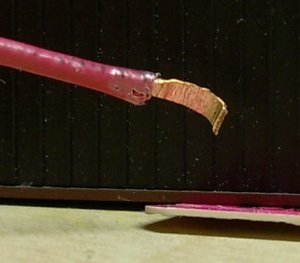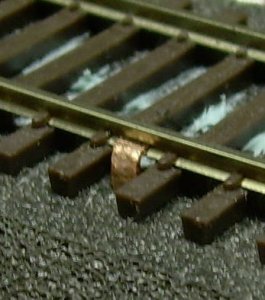When connecting extra feeder lines to the track, what size wire is used to follow the track and how to connect to this? Is speaker wire about right, with the speaker wire from the controller and feeder wires tapped into it at intervals? Same side of track wire to same side of speaker wire all around?-----John R
Feeder lines
- Thread starter jr switch
- Start date
You are using an out of date browser. It may not display this or other websites correctly.
You should upgrade or use an alternative browser.
You should upgrade or use an alternative browser.
I use 14 gauge wire for my buss lines and feeders. Always with red for the outside rail, black for the inside rail. I solder the wire directlt to the rail. Some modellers use terminal joiners. If you don't know what these are, they are rail joiners with a little extension on one side to solder a wire to.
Speaker wire, 16-18 gauge, should be about right for the bus (which follows the track as you say) then, about every 10 feet add a drop... this can be about 20-22 gauge wire. Industry standards dictate red on the outside track, as stated by Jeff. If you use the terminal wires, convenient but expensive, tie a knot in the outside feeder, to keep things straight, as Atlas makes them only in black.
Does any company make terminal joiners that come in two colors?
Does any company make terminal joiners that come in two colors?
Thank you Jeffrey and Kyle-------I have four packets of the joiners with the wire already soldered to them and will heed your advice on proper connections---Right now, pre-layout period, I'm just using an oval with 22" radius curves and two sections of straight track on each side [ temporary work room set-up ] until I have the room set up downstairs for the full layout. So, with what I'm learning on the forum, I'll know how to properly wire from the start, at least the basics for the track----Thanks again guys----John R
There is not a lot of wattage going to it, O ga with a big ZW almost calls for auto jumper cables, LOL, but speaker wire works. I have used it.
No negative effects electrically.Max said:Would there be any negative effect to using solid 12 AWG wire for feeder wire? I happen to have a good supply of six inch lengths of that, and I was planning to peen the ends down then solder them to the bottoms of the rails.
Practically, it takes considerably more heat to solder 12 gauge wire to rail, which will significantly increase your risk of melted ties. Also, the solid 12 gauge is not flexible so may cause misalignments in your track when you pull the feeder through the holes in the benchwork. Last disadvantage to such heavy feeders is hiding them visually.
Personally, I go the opposite direction using 26 gauge solid magnet wire for feeders. Magnet wire has a varnish coating for insulation. The feeders are soldered to the underside of the rail where practical, on the side where it's not. The feeder is tied to the bus which is much heavier (16 gauge) underneath the layout. My feeders are never more than 12 inches long and often less.
I don't run long trains on a small layout, and I at most will double-head 2 locos, so my current draws are modest (less than 1 amp) even with older locomotives with open frame motors.
my thoughts, your choices
pgandw said:No negative effects electrically.
Practically, it takes considerably more heat to solder 12 gauge wire to rail, which will significantly increase your risk of melted ties. Also, the solid 12 gauge is not flexible so may cause misalignments in your track when you pull the feeder through the holes in the benchwork. Last disadvantage to such heavy feeders is hiding them visually.
Personally, I go the opposite direction using 26 gauge solid magnet wire for feeders. Magnet wire has a varnish coating for insulation. The feeders are soldered to the underside of the rail where practical, on the side where it's not. The feeder is tied to the bus which is much heavier (16 gauge) underneath the layout. My feeders are never more than 12 inches long and often less.
I don't run long trains on a small layout, and I at most will double-head 2 locos, so my current draws are modest (less than 1 amp) even with older locomotives with open frame motors.
my thoughts, your choices
I htink there may be some confusion as to what feeder wire is. I use 10 ga wire for busses on my modules because I had a bunch of #10 three wire "romex" left over from a house construction project. I use #20 ga drop wires soldered to the rails and "dropped" through the benchwork to the buss wire. By the way the 20 ga drops are what our club module standards call for because we run a wireless dcc control system and have found it to be intolerant of any voltage drops or even slightly dirty track. Maximum length for a drop wire is 6 inches to avoid voltage drops. I think when Max mentioned #12 awg wire for feeders, he was referring to his buss wire rather than the drops.
Sorry if I wasn't clear. I'm using 12/2 AWG for a bus line but I have a lot of pieces of solid single strands of 12AWG and I was hoping to use them for feeders. When I put them under the Code 100 HO track it caused a huge bump, so I figured I could peen the end flat and slide it under there to solder. Most of the resources I've found suggest 22-26 AWG, but I couldn't find any of that at the Home Deopt or Lowe's, and if I did it would probably be expensive ( I got the bus line 12/2 for free).
It seemed to me that using 6 inch lengths of 12AWG for feeders was a good idea, but bitter experience has long since taught me that anything that seems like a good idea probably isn't.
Pgandw, thanks for the insight. I hadn't considered the part about soldering. I was planning to solder the feeders to the line then poke them down through the board and use 3M connectors to attach the bus. I hope to staple the bus to the bottom of the plywood so it doesn't shift around. Theoretically, the bus wires will not be penetrated by staples and short out.
Russ, is it just the wireless DCC that is intolerant of voltage drops? We have a Digitrax system for this layout but it is not wireless. The eventual intention is to employ the JMRI system from a computer; would that be affected? This track was brand new but it's already pretty dirty and we haven't even run a train on it yet.
vbmenu_register("postmenu_223767", true);
It seemed to me that using 6 inch lengths of 12AWG for feeders was a good idea, but bitter experience has long since taught me that anything that seems like a good idea probably isn't.
Pgandw, thanks for the insight. I hadn't considered the part about soldering. I was planning to solder the feeders to the line then poke them down through the board and use 3M connectors to attach the bus. I hope to staple the bus to the bottom of the plywood so it doesn't shift around. Theoretically, the bus wires will not be penetrated by staples and short out.
Russ, is it just the wireless DCC that is intolerant of voltage drops? We have a Digitrax system for this layout but it is not wireless. The eventual intention is to employ the JMRI system from a computer; would that be affected? This track was brand new but it's already pretty dirty and we haven't even run a train on it yet.
vbmenu_register("postmenu_223767", true);
MAX:
Is there a Lowes, Radio Shack or any other electronics store near you? They would certainly have small gauge feeder wire in stock. TTFN.....
Is there a Lowes, Radio Shack or any other electronics store near you? They would certainly have small gauge feeder wire in stock. TTFN.....
Do Terminal joiners exsist that have a place to solder a feeder wire too? I have seen some that shaped like a "T" but they come out sideways from the track. I would think something like a "T" but the bottom part of the "T" would project down so that you could attach a feeder. Anything out there like this?
Hope this makes sense?
Hope this makes sense?
Attachments
#12 awg is just was too big for feeder wires. You will have difficulty soldering it to the rails because of it's size. You will have difficulty concealing it after it is connected.
I greatly appreciate all the comments and I've copied them down for discussion with the group. The soldering tutorial elsewhere on the board has been very useful, and so have many other items of information here.
I'll look again this weekend for smaller AWG wire, especially the magnet wire, although the Digitrax book suggests 22-24 gauge, so 26 might be a little small. If I can get a good deal on the small wire I will probably go with that but if not I think I'll test peening the 12AWG and see how it solders. Thanks again.
I'll look again this weekend for smaller AWG wire, especially the magnet wire, although the Digitrax book suggests 22-24 gauge, so 26 might be a little small. If I can get a good deal on the small wire I will probably go with that but if not I think I'll test peening the 12AWG and see how it solders. Thanks again.
Model Railroader Magazine had a section recently on feeder wires. The technique is to drill a hole straight down next to track (outside of rail, obviously). Then take the smallest guage solid copper wire you can purchase (16g at my local home supply store), cut it to length to reach your bus beneath the layout, and remove 1/2" of inssulation from both ends. Then take one end and using a hammer, pound the wire flat to create a spade of sorts. Next, take your rail cutter and shape it so it is square on the end, bend it in a right angle with only about 1/32" beyond the bend and then drop the other end down the hole you drilled. Tin the business end of the feeder and the track (flux is good) and you end up with a very low profile and nearly invisible feed once the track is weathered.
I used to bend the feeder to fit in the groove on the outside of the rail but this is truly a superior method.
I used to bend the feeder to fit in the groove on the outside of the rail but this is truly a superior method.
Thanks for the pictures, Rusty Spike. I was planning to peen them and slide under the rail bottoms, but the pictured way might be better. I foresee melted ties and big silver globs along the mainline, but maybe the balllast will cover things.
Jim, you are probably right about 12 gauge being overkill. But the electrical supply store wasn't open today and if the trains do not start running soon the workers will revolt.
Jim, you are probably right about 12 gauge being overkill. But the electrical supply store wasn't open today and if the trains do not start running soon the workers will revolt.


